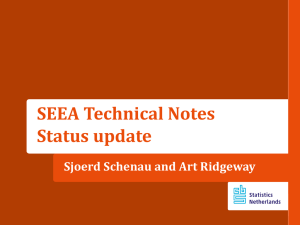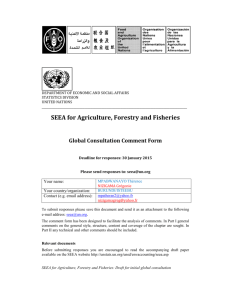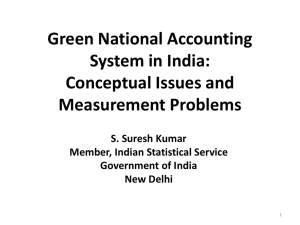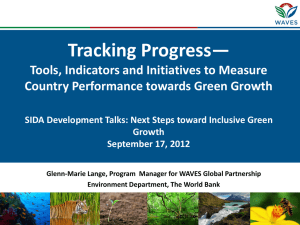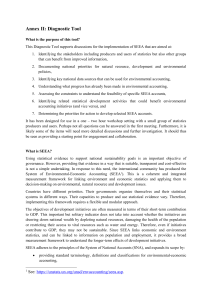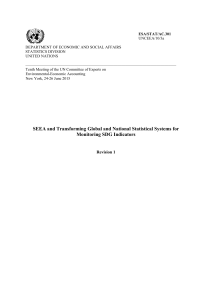SEEA and SDGs Note_Rev 1
advertisement
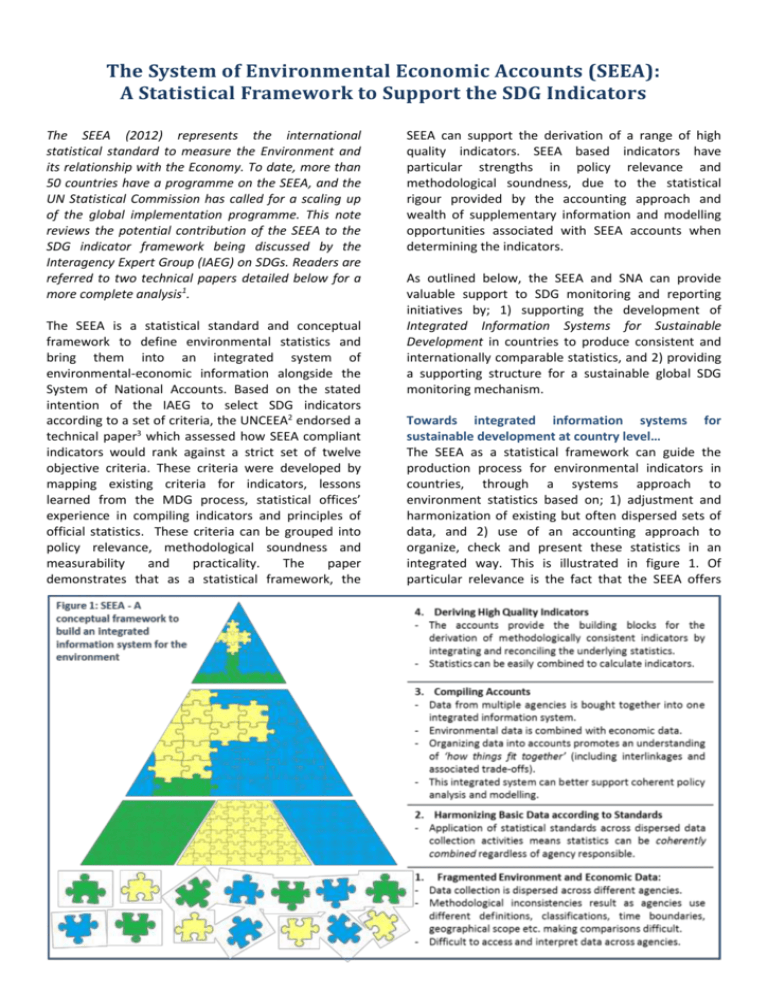
The System of Environmental Economic Accounts (SEEA): A Statistical Framework to Support the SDG Indicators The SEEA (2012) represents the international statistical standard to measure the Environment and its relationship with the Economy. To date, more than 50 countries have a programme on the SEEA, and the UN Statistical Commission has called for a scaling up of the global implementation programme. This note reviews the potential contribution of the SEEA to the SDG indicator framework being discussed by the Interagency Expert Group (IAEG) on SDGs. Readers are referred to two technical papers detailed below for a more complete analysis1. The SEEA is a statistical standard and conceptual framework to define environmental statistics and bring them into an integrated system of environmental-economic information alongside the System of National Accounts. Based on the stated intention of the IAEG to select SDG indicators according to a set of criteria, the UNCEEA2 endorsed a technical paper3 which assessed how SEEA compliant indicators would rank against a strict set of twelve objective criteria. These criteria were developed by mapping existing criteria for indicators, lessons learned from the MDG process, statistical offices’ experience in compiling indicators and principles of official statistics. These criteria can be grouped into policy relevance, methodological soundness and measurability and practicality. The paper demonstrates that as a statistical framework, the SEEA can support the derivation of a range of high quality indicators. SEEA based indicators have particular strengths in policy relevance and methodological soundness, due to the statistical rigour provided by the accounting approach and wealth of supplementary information and modelling opportunities associated with SEEA accounts when determining the indicators. As outlined below, the SEEA and SNA can provide valuable support to SDG monitoring and reporting initiatives by; 1) supporting the development of Integrated Information Systems for Sustainable Development in countries to produce consistent and internationally comparable statistics, and 2) providing a supporting structure for a sustainable global SDG monitoring mechanism. Towards integrated information systems for sustainable development at country level… The SEEA as a statistical framework can guide the production process for environmental indicators in countries, through a systems approach to environment statistics based on; 1) adjustment and harmonization of existing but often dispersed sets of data, and 2) use of an accounting approach to organize, check and present these statistics in an integrated way. This is illustrated in figure 1. Of particular relevance is the fact that the SEEA offers the conceptual framework and associated methods (including definitions, classifications and accounting concepts) to integrate environmental data with economic information, so as to capture interlinkages and trade-offs between the environment and the economy. Furthermore, implementation of the SEEA often necessitates the development of important institutional mechanisms between relevant actors within National Statistical Systems. This can help to strengthen the production process for environment information, by triggering consolidation of data collection activities and improved coordination in the processing and production of statistics. Such institutional mechanisms can also support better use of information produced. SEEA implementation requires close cooperation between National Statistical Offices and those agencies which collect and use specific environment information for policy. This cooperation helps to ensure; 1) priority is given to producing information needed for policy, 2) line agencies understand and vet the information being produced and use it for policy making, and 3) data silos are broken with information from different agencies integrated into one system, providing improved support to policy integration. Towards a sustainable and integrated global monitoring mechanism for the SDGs… The use of an established statistical standard such as the SEEA in the definition and measurement of SDG indicators will promote international comparability and consistency across countries. Application of standards will also make indicators less prone to continued discussion about definitions and the quality of indicators being produced. Furthermore, the SEEA is a system of accounts, meaning it provides the statistical framework to measure many facets of the environment and economy in a coherent and integrated way (including but not limited to water, energy, material flows, emissions, economic instruments, environmental industries, land, forests and ecosystems). Defining relevant SDG indicators (i.e. those related to the environment and its link to the economy) according to the SEEA therefore provides a conceptual basis upon which an integrated indicator framework can be built, whereby one standard approach links indicators across goals and at different levels of monitoring4. Basing SDG monitoring mechanisms on statistical standards such as the SEEA will also provide impetus and support for the alignment and consolidation of international reporting mechanisms which until now have been siloed within mandated international organizations5. This will help to mitigate the methodologically fractured and overlapping nature of statistical initiatives undertaken by various international organizations in countries. By adopting a common approach to environment and economic statistics, associated international capacity building programmes will become mutually reinforcing, translating to more sustainable national ownership in compilation and reporting on SDG indicators at the global level. The processes of 1) building national capacity for SDG indicators; and 2) aligning to a standards-based approach for statistics are therefore mutually reinforcing6. Finally, it expected that over time alignment to statistical standards will reduce the reporting burden placed on countries, by avoiding arduous data adjustments needed to respond to differing requests from international organizations. National statistical systems will benefit from a streamlined ‘information provision system’ by which countries’ SEEA accounts can inform multiple and different requests for information (both from national and international entities). Where do we go from here? An analysis of the indicators circulated to the IAEG on 7th July 2015, which scopes those of relevance to the SEEA and provides initial comments on work which needs to be done to align these indicators to the SEEA standard, have been submitted alongside this note. The UNCEEA will continue to work on this technical alignment over the coming months and submit this input to the IAEG-SDGs in due time. 1 See the following two papers: 1) UNCEEA 10/3a; “SEEA and Transforming Global and National Statistical Systems for Monitoring SDG Indicators” Rev 1, and 2) UNCEEA 10/3b: “The SEEA as the Statistical Framework in meeting Data Quality Criteria for SDG indicators” Rev 1 2 The UNCEEA is the committee of experts on environmental economic accounting established by the UN Statistical Commission and comprising member states and international agencies, tasked with the mainstreaming of the SEEA and related statistics and advancing implementation of the SEEA in countries. . 3 See UNCEEA 10/3b 4 E.g. ensuring coherent application of concepts, and consistent use of standard classifications and definitions across goals and levels of disaggregation. 5 While it is recognised that some joint monitoring initiatives exist between international organizations, more work is needed to ensure methodological coherence across international reporting initiatives both within and across thematic areas. 6 For a more detailed discussion refer to UNCEEA 10/3a Rev 1, Section 4.
